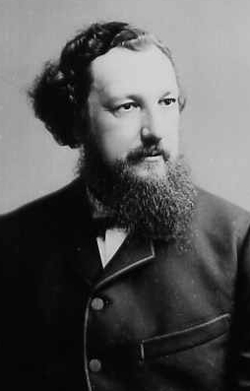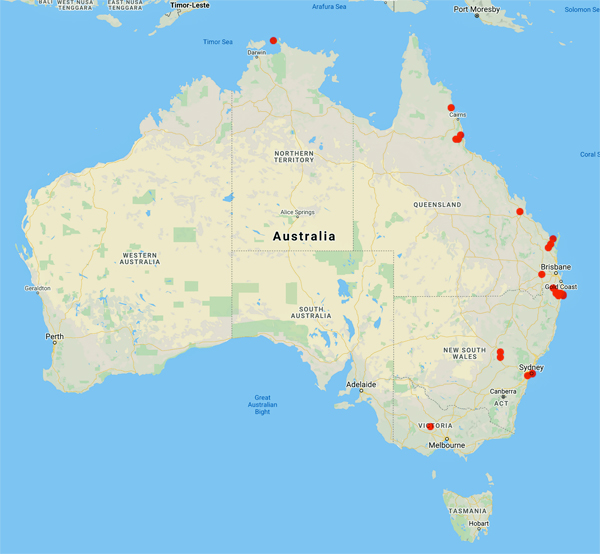
Council of Heads of Australasian Herbaria
Australian National Herbarium
Biographical Notes
 |
Council of Heads of Australasian Herbaria |
 Ramsay, Edward Pearson (1842 - 1916)
Ramsay, Edward Pearson (1842 - 1916)Born at 'Dobroyde', Ashfield (now Haberfield: Sydney), NSW, on 3 December 1842; died at 'Truro', Queensborough Road, Croydon Park (Sydney), NSW, on 16 December 1916.
An Australian born zoologist specialising in
ornithology, with occasional plant collections.
Edward was born at Ashfield (now Haberfield, a Sydney
suburb), in 1842 and spent much of
his early life on the family estate.
He was first
educated at St Mark's Collegiate School, initially at Darling
Point, and later
when the school was moved, at Macquarie Fields.
He then matriculated to The University of Sydney in
1863 and entered St Paul's College where he
studied medicine until December 1865.
Although Edward had no formal scientific training in
zoology, he had a keen interest in natural history. His speciality was ornithology, but he also
expressed an interest in ichthyology, herpetology, mammalogy and botany.
On 15 December 1867 Edward opened
his newly-established 'Dobroyd New Plant and Seed Nursery' on the portion (the garden) of
the Dobroyd family estate which he inheriteds and was "... engaged in its management until
he was appointed Curator of the Australia Museum, Sydney".
From 1868 for several years, he was part
owner with a number of his brothers, in the Sindah Sugar Plantation, on the Mary River,
Marvborough, Qld.
He was first connected with the Australian Museum, Sydney in 1860, but was
shunned by the then Curator of the Museum, Johann L.G. Krefft, who saw him "as an
enemy of mine of long standing on account of my refusing to purchase the rubbish he used to
offer". George Masters and Sir William J. Macleay gave evidence to the Legislative
Assembly Select Committee inquiring into the Museum in 1874 to testify against Krefft, which
ultimately lead to his dismissal.
In the same year, on 22 February, the
Trustees of the Museum illegally appointed Edward as curator and it was not until 1876 that
he was officially appointed by government as the first Australian-born Curator of the Australian Museum,
Sydney.
After his marriage to Ellen Eliza Fox at Burwood (Sydney) on 7 November 1876, they
lived in the Curator's quarters on the top floor of the Australian Museum in College Street, Sydney, and it was
here that five of their six chldren were born between 1877 and 1888. He held this position
until 31 December 1894, when he had to resign because of declining health. After his
resignation as Curator, Edward served the Museum as a consulting ornithologist until 28 February
1909.
He was a founding Treasurer of the Entomological Society of New South Wales (from 1862)
until it was linked with the Linnean Society of New South Wales (1874, continuing until 1892).
of which he was also a founding member. As well as being a member of the Philosophical
Society of New South Wales (June 1865) he was made a life member when the Society
merged with the Royal Society of New South Wales. He was a trustee for both the Sydney
Hyde, Phillip and Cook Parks (from 1878) and the Zoological Station at Watsons Bay (from
1879) and was elected an honorary menmber of the Royal Society of Tasmania (May
1885). In 1886 "... the Senate of the University of St. Andrews conferred on Mr. Ramsay the
honorary degree of Doctor of Laws."
One of the specimens he collected in the Top End of Northern Territory became the Type of the palm Hydriastele ramsayi, the species name honouring Edward Pearson Ramsay.
Another palm, Licuala ramsayi, was originally named Livistona ramsayi, by Mueller in honour of E.P. Ramsay.
Source: Extracted from book: 'Passions in Ornithology: A century of Australian Egg Collectors' (2020), Mason & Pfitzner, Canberra. [consult for source references]
Australian Plant Name Index (APNI) records, via The National Species List database, https://www.biodiversity.org.au/nsl/services/APNI [accessed 13 January 2022]
https://id.biodiversity.org.au/name/apni/81640/api/apni-format
Portrait Photo: Courtesy of Belinda Cohen, via Google Images.
Data from 136 specimens
